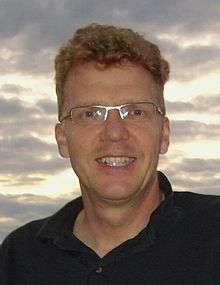Max Planck Institute for Astronomy
The Max-Planck-Institut für Astronomie (Max Planck Institute for Astronomy, MPIA) is a research institute of the Max Planck Society (MPG). It is located in Heidelberg, Baden-Württemberg, Germany near the top of the Königstuhl, adjacent to the historic Landessternwarte Heidelberg-Königstuhl astronomical observatory. The institute primarily conducts basic research in the natural sciences in the field of astronomy.
 MPIA logo | |
| Founder(s) | Hans Elsässer |
|---|---|
| Established | 1969 |
| Focus | Astronomy |
| Managing Director | Hans-Walter Rix |
| Key people | Thomas Henning |
| Location | , , |
| Address | Königstuhl 17, 69117 Heidelberg, Germany |
| Website | Official website |
In addition to its own astronomical observations and astronomical research, the Institute is also actively involved in the development of observation instruments. The instruments or parts of them are manufactured in the institute's own workshops.
History

The founding of the institute in 1967 resulted from the insight that a supra-regional institute equipped with powerful telescopes was necessary in order to conduct internationally competitive astronomical research. Hans Elsässer, an astronomer, became the founding director in 1968. In February 1969, a first group of 5 employees started work in the buildings of the neighbouring Königstuhl State Observatory.[1] The institute, which was completed in 1975, was initially dedicated to the preparation and evaluation of astronomical observations and the development of new measurement methods.
From 1973 to 1984, it operated the Calar Alto Observatory on Calar Alto near Almería together with Spanish authorities. This largest observatory on the European mainland was used equally by astronomers from both countries until 2019. On 23 May 2019, the regional government of Andalusia and the MPG signed a transfer agreement for the 50% share in the observatory. Since then, it has been owned exclusively by Spain.[2]
Since 2005, the MPIA has been operating the Large Binocular Telescope (LBT) together with partners from Germany, Italy and the USA and equipping it with measuring instruments. The LBT is located on Mount Graham near Tucson, Arizona, which is 3190 m high. On its mount, it carries two primary mirrors, each 8.4 meters in diameter, making it the largest optical reflecting telescope with single monolithic primary mirrors in the world.
Research interests
Two scientific questions are given priority at the MPIA. One is the formation and development of stars and planets in our cosmic neighbourhood. The resonating question is: Is the Sun with its inhabited planet Earth unique, or are there also conditions in the vicinity of other stars, at least the numerous sun-like ones among them, that are conducive to life? On the other hand, the area of galaxies and cosmology is about understanding the development of today's richly structured Universe with its galaxies and stars and its emergence from the simple initial state after the Big Bang.
The research topics at a glance:
- Star formation and young objects, planet formation, astrobiology, interstellar matter, astrochemistry
- Structure and evolution of the Milky Way, quasars and active galaxies, evolution of galaxies, galaxy clusters, cosmology
Together with the Center for Astronomy at the University of Heidelberg, the Heidelberg Institute for Theoretical Studies (HITS) and the Department of Astro- and Particle Physics of the MPI for Nuclear Physics (MPIK), the MPIA in Heidelberg is a globally renowned centre of astronomical research.
Since 2015, the MPIA has been running the "Heidelberg Initiative for the Origins of Life" (HIFOL)[3] together with the MPIK, the HITS, the Institute of Geosciences at Heidelberg University and the Department of Chemistry at the Ludwig Maximilian University Munich (LMU). HIFOL brings together top researchers from astrophysics, geosciences, chemistry and the life sciences to promote, strengthen and combine scientific research towards the prerequisites for the emergence of life.
Structure
- Galaxies and Cosmology Department (Hans-Walter Rix)
- Gaia Galactic Survey Mission (Coryn Bailer-Jones)
- Supermassive black holes and galaxies in the epoch of reionization (Eduardo Banados)
- Stellar spectroscopy and populations (Maria Bergemann)
- AGN Jet Physics (Christian Fendt)
- High angular resolution astronomy (Tom Herbst)
- Coevolution of Galaxies and Black Holes (Emmy Noether)
- Euclid Mission Group (Knud Jahnke)
- Stellar Physics and the Evolution of Chemical Elements (Karin Lind)
- Structure of Active Galactic Nuclei (Klaus Meisenheimer)
- Galactic Nuclei (Nadine Neumayer)
- Galaxies and Cosmology Theory (Annalisa Pillepich)
- Black Hole and Accretion Research/Instrumentation (Jörg-Uwe Pott)
- Galaxy Evolution and Milky Way groups (Hans-Walter Rix)
- Extragalactic Star Formation (Eva Schinnerer)
- Interstellar Matter and High-z QSOs (Fabian Walter)
- Planet and Star Formation Department (Thomas K. Henning)
- Star Formation (Henrik Beuther)
- Planet Formation in Accretion Discs (Bertram Bitsch)
- Adaptive Optics (Wolfgang Brandner)
- Unveiling Planet Formation by Simulations and ObservationS (Mario Flock)
- Center "Frontiers of Interferometry in Germany" (Thomas K. Henning)
- Disks and Exoplanets (Thomas K. Henning)
- Laboratory Astrophysics (Cornelia Jäger)
- Theory of Planet and Star Formation (Hubert Klahr)
- Infrared Space (Oliver Krause)
- The Genesis of Planets (Paola Pinilla)
- Technical Departments
Instrumentation
The MPIA also builds instruments or parts of them for ground-based telescopes and satellites, including the following:
- Calar Alto Observatory (Spain)
- La Silla Observatory of the European Southern Observatory (ESO)
- Paranal Observatory and E-ELT (ESO)
- Large Binocular Telescope
- Infrared Space Observatory (ESA)
- Herschel Space Observatory (ESA, NASA)
- James Webb Space Telescope (NASA, ESA)
The MPIA is also participating in the Gaia mission. Gaia is a space mission of the European Space Agency (ESA), in which the exact positions, distances and velocities of around one billion Milky Way stars are determined.
Directors

- Hans Elsässer, Founding director, 1968–1997[4]
- Guido Münch, 1978–1989[4]
- Steven Beckwith, 1991–2001[4]
- Immo Appenzeller, 1998–2000 (interim)[1]
- Hans-Walter Rix, since 1999[4]
- Thomas Henning, since 2001[4]
Infrastructure
The managing director is Hans-Walter Rix (August 2019). Former and current external scientific members of the MPIA were and are:[5][6]

- Prof. Dr. Karl-Heinz Böhm (†)
- Prof. Dr. Walter Fricke (†)
- Prof. Dr. George H. Herbig (†)
- Prof. Dr. Conny Aerts (University of Leuven/Radboud University Nijmegen)
- Prof. Dr. Immo Appenzeller (Emeritus, Heidelberg University)
- Prof. Dr. Steven V.W. Beckwith (University of California, Berkeley)
- Prof. Dr. Willy Benz (University of Bern)
- Prof. Dr. Rafael Rebolo (Instituto de Astrofísica de Canarias)
- Prof. Dr. Volker Springel (Max Planck Institute for Astrophysics)
At the end of 2018, a total of 413 people were employed at the Institute, including 227 scientists, among them 34 junior and visiting scientists. In the same year, 79 doctoral students were supervised in cooperation with the University of Heidelberg. Nine independent research groups have been established at the MPIA per 2018. These include three Max Planck Research Groups[7] and five European research groups. One group is funded by the Alexander von Humboldt Foundation.[8]
Graduate program
The MPIA participates in the International Max Planck Research School (IMPRS) for Astronomy and Cosmic Physics. The IMPRS is an English-language doctoral program that started in 2005. Other partners of the IMPRS are the MPIK, the Center for Astronomy at the University of Heidelberg and the HITS. Since 2007, the IMPRS has been part of the Heidelberg Graduate School of Fundamental Physics.[9] Spokespersons of the IMPRS are Hans-Walter Rix from MPIA and Stefan Wagner from the Landessternwarte Heidelberg.[10]
Public relations and outreach
The MPIA hosts the editorial office of the popular journal Sterne und Weltraum(lit. Stars and Space), which was founded in 1962 by Hans Elsässer, later founding director of the MPIA, among others. It is also the patron of the Wissenschaft in die Schulen! (lit. Science into Schools) initiative[11], which develops educational materials for secondary schools. In December 2008, the institute and the Klaus Tschira Foundation announced their intention to bundle the activities of the Heidelberg astronomers in public relations and work with pupils and teachers in a newly founded Haus der Astronomie.
Haus der Astronomie

In 2009, "Haus der Astronomie," a center for astronomy education and outreach was founded on the MPIA campus. The center is a partnership between the Max Planck Society, the Klaus Tschira Foundation, Heidelberg University and the City of Heidelberg. The center's galaxy-shaped building, funded and constructed by the Klaus Tschira Foundation, was opened in December 2011. It is operated by the Max Planck Society, which has delegated the task to the Max Planck Institute for Astronomy.[12]
Activities in Haus der Astronomie include public talks and guided tours, planetarium shows, workshops for school classes or kindergarten groups, the development of educational materials, pre-service training for teacher students at Heidelberg University and in-service training for German and international teachers.[12]
References
- Lemke, Dietrich. (2011). Im Himmel über Heidelberg : 40 Jahre Max-Planck-Institut für Astronomie in Heidelberg (1969-2009). Berlin: Archiv der Max-Planck-Gesellschaft. ISBN 9783927579255. OCLC 795320685.
- "Junta de Andalucía and the Max-Planck Institute make official the transfer of 50% of the Calar Alto Observatory". www.caha.es. Retrieved 2019-08-08.
- "Heidelberg Initiative for the Origins of Life – HIFOL". MPIA | Origins of Life. Max Planck Institute for Astronomy (MPIA). Retrieved 2019-08-22.
- Henning, Eckart. (2011). Chronik der Kaiser-Wilhelm-Max-Planck-Gesellschaft zur Förderung der Wissenschaften, 1911-2011 : Daten und Quellen. Kazemi, Marion. Berlin: Duncker & Humblot. ISBN 9783428136230. OCLC 734081095.
- Wallerstein, George (2014-06-05). "Karl-Heinz Hermann Böhm". Physics Today. doi:10.1063/PT.5.6067.
- "Board of directors". www.mpia.de. Retrieved 2019-08-08.
- "Research groups leaders". www.mpg.de. Retrieved 2019-08-08.
- Fendt, Christian; Henning, Thomas; Kürster, Martin; Pössel, Markus; Rix, Hans-Walter (2019). Pössel, Markus; Nielbock, Markus (eds.). Annual Report 2018. Max Planck Institute for Astronomy. Heidelberg: Thomas Henning, Hans-Walter Rix. ISSN 1437-2924.
- "Topical Graduate Schools". HGSFP - Heidelberg Graduate School for Physics. Retrieved 2019-08-22.
- "IMPRS officials". International Max Planck Research School for Astronomy and Cosmic Physics at the University of Heidelberg (IMPRS-HD). Retrieved 2019-08-22.
- "Schirmherren". Wissenschaft in die Schulen! – WIS (in German). Retrieved 2019-08-22.
- Lemke, Dietrich. (2011). Im Himmel über Heidelberg : 40 Jahre Max-Planck-Institut für Astronomie in Heidelberg (1969-2009). Berlin: Archiv der Max-Planck-Gesellschaft. ISBN 9783927579255. OCLC 795320685.
External links
- Homepage of the Max Planck Institute for Astronomy
- Homepage of the International Max Planck Research School (IMPRS) for Astronomy and Cosmic Physics
- Homepage of Haus der Astronomie
| Wikimedia Commons has media related to Max Planck Institute for Astronomy. |